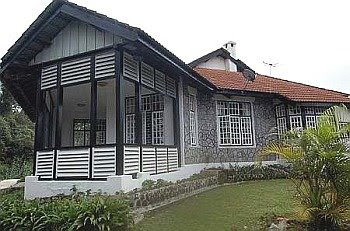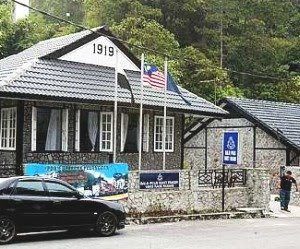By Leong Siok Hui
Saturday March 22, 2008
Colonial bungalows in Fraser’s Hill make the perfect getaway for city folks.
When we pulled into the driveway, the bungalow was shrouded in thick fog. It was about 7.30pm and the air was chilly. Lit by fluorescent lamps, the English-style cottage has white, timber window frames and granite stonewalls hedged by pretty yellow flowers.
We felt like we’d arrived in an English countryside though we were a mere two hours’ drive from Kuala Lumpur.

The Jelai Bungalow has a spacious verandah, as well as a chimney, which is typical in all the mock Tudor-style bungalows on Fraser's Hill. — Reza Azmi
My friends, Jo, Bryon, Reza and I were weekend guests at the Brinchang (Dacres) Bungalow in Fraser’s Hill. Brinchang is one of the six colonial bungalows owned by the Pahang government and managed by Highlands Resthouse Holdings (HRH), a private company based in KL.
Our weekend plan was simple – hike the Pine Hill, chill out at the bungalow and enjoy the crisp weather.
Brinchang’s caretaker, Lim Tee Tuang, 68, and his wife, Tan Lee Hong, 61, welcomed us at the door. During our stay, the couple took care of all our needs – they whipped up home-cooked food, kept the house spick and span and made sure we had endless supply of hot tea and coffee.
The cosy living room was decorated with comfy, white wicker sofas, blue-and-white striped curtains, a fireplace and lovely bay windows – which made you want to curl up in the corner with a good book. Aside from an antique chest painted white, the rest of the decor was nondescript.
There were also modern amenities like a television, DVD player and a fridge. We could also call ahead and requested for Lim to stock up on firewood and keep the hearth burning.
Our spacious bedrooms came with a couple of antique furniture pieces like a cloak hanger and dressing table. I adored the large bathroom space – you could literally kick up some salsa moves in there, and the classic bathtub equipped with hot shower. The fluffy towels and crisp linens were also plus points.

The Parr bungalow is reminiscent of the black and white bungalows built during colonial days. Typical characteristics include black door and window frames with white plaster walls.
Impeccable service
After a quick wash, we sat down to a nice spread of stir-fry greens, hot vegetable soup, sweet and sour chicken served with hot, steaming rice. Dinner was just a prelude to the fine meals to come.
Though Lim, 68, is Hainanese, he didn’t come from a family of caretakers like his peers in Fraser’s. Originally from Johor, Lim, a retired teacher, was posted to Fraser’s more than 40 years ago.
He met his wife who was born and bred in Fraser’s. Tan has been working as a helper at the various bungalows for 38 years. When Lim retired, he took on the caretaker’s job. The Lims’ children live and work in KL but the couple is happy living in Fraser’s.
The next day, we woke up to the aroma of freshly brewed coffee. Breakfast was hot, freshly baked scones served with clotted cream, homemade marmalade and omelette. For lunch, the Lims’ served fish and chips – generous servings of dory coated with breadcrumbs and deep-fried, and served with side dish of homemade mashed potatoes, coleslaw and stir-fry French beans.
Dinner that night was another display of Lim’s cooking talent – crispy-fried chicken doused in lemon sauce, stir-fry cauliflower, carrots and mushrooms and Kapitan chicken curry (a Nyonya dish). For our day hike in Pine Hill, Tan packed some delicious fried rice with her homemade sambal belacan.
The colonial architecture
The hill station retreat of Fraser’s is known for its quaint, mock Tudor-style cottages that date back to the 1920s. Today, with the exception of privately owned bungalows, most of the government houses have either been torn down, are dilapidated or in a state of disrepair. To our pleasant surprise, the HRH-managed bungalows are kept in tip-top condition. The bungalows were named after the early British Residents of Pahang like Clifford (Jelai), Wray (Temerloh), Parr (Pekan), Dacres (Brinchang) and Kindersley (Raub).
According to The Encyclopaedia of Malaysia – Architecture, the earliest bungalows were low, oblong or square buildings with one or more verandahs and a porte-cochere (porch). The Parr bungalow facing the Fraser’s golf course sports a porte-cochere. At the rear of the building sit the kitchen, the servants’ quarters and the storeroom.
Most of the early bungalows were designed by amateur architects – mainly military engineers or Public Works Department employees. The mock Tudor style came from the revival of the Romantic movement in Britain in the late 19th and early 20th centuries. Inspired by medieval England, this vernacular style is typified by half-timber frame houses with steeply pitched roofs, gables, narrow windows or small window panes and large chimneys.
In Fraser’s, the typical bungalow sports a timber structure and limestone or concrete walls.
“One of our main challenges is high maintenance,” admitted HRH’s resident manager Donald Johnson. When the old houses are left empty for a while and not aired regularly, they take on a musty smell and mould appears on the furniture and walls. The paint peels and the creepy-crawlies come in droves.
“In 2007, the company spent RM150,000 on maintenance alone,” said Johnson.

Fireplaces are commonplace in the living rooms of the colonial bungalows.
“The monthly costs per bungalow average around RM3,000 which goes to paying full-time caretakers and helpers, utility bills and the upkeep of the place.”
Last year, the occupancy rates were about 65% to 70%. On average, the bungalows are booked three weeks in a month and peak during school holidays and festive occasions.
The Brinchang bungalow, for instance, sleeps up to nine people comfortably. And the weekday rental rate is a steal at RM500 per bungalow per day. Meals are separate and cost about RM16 (lunch) to RM28 (dinner).
“Most of the guests here come for the food,” said Johnson. “The caretakers are a dying breed with their high level of service and excellent cooking. Even something as simple as a gravy sauce can be a family secret handed down through generations.”
“I think our biggest challenge is keeping the caretaker tradition alive and maintaining the colonial style of service, ambience and food,” said Johnson who also runs the Raub Resthouse in Raub town, Pahang.
As for us, the memories of lounging in the garden, sipping wine and savouring the view of the valley summed up our perfect weekend getaway. What a life!
# The word “bungalow” originates from the modest Bengal house – a timber structure with a thatched roof and a veranda built on the ground. The bungalow in Malaysia typically refers to a large, airy, detached one or two-storey house built from timber or brick and covered by a hipped roof...” – The Encyclopaedia of Malaysia – Architecture
Source: Star Travel & Adventure


